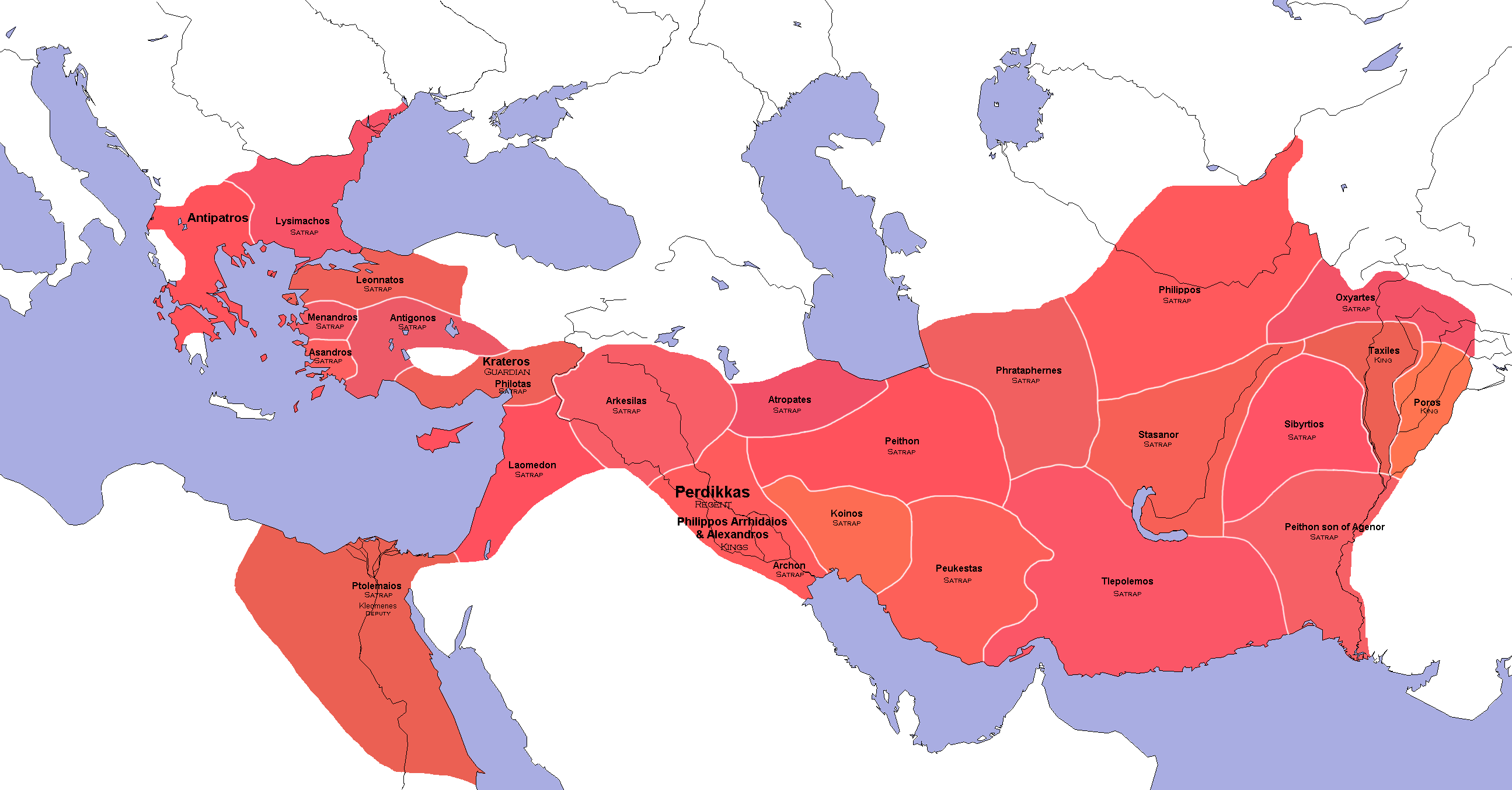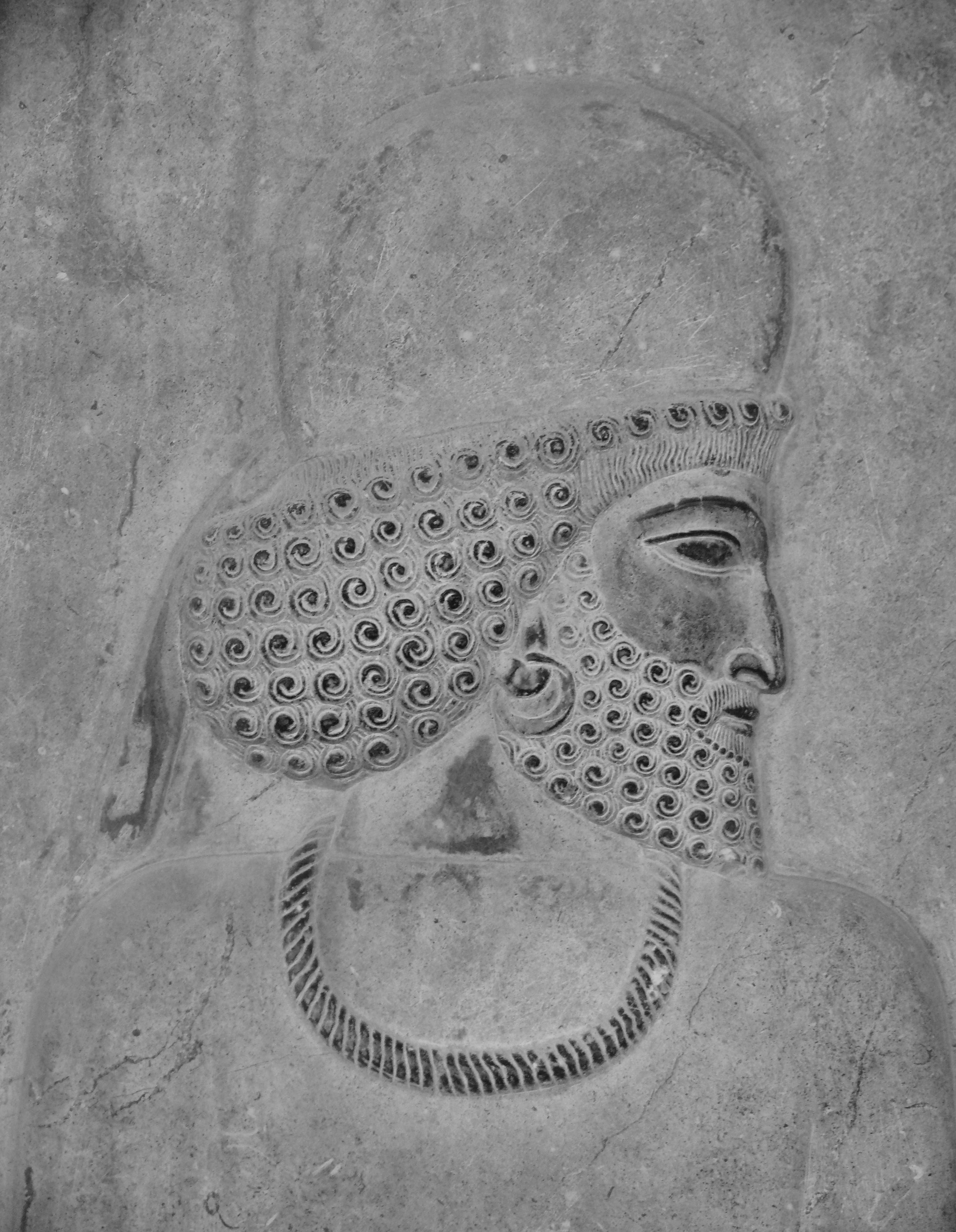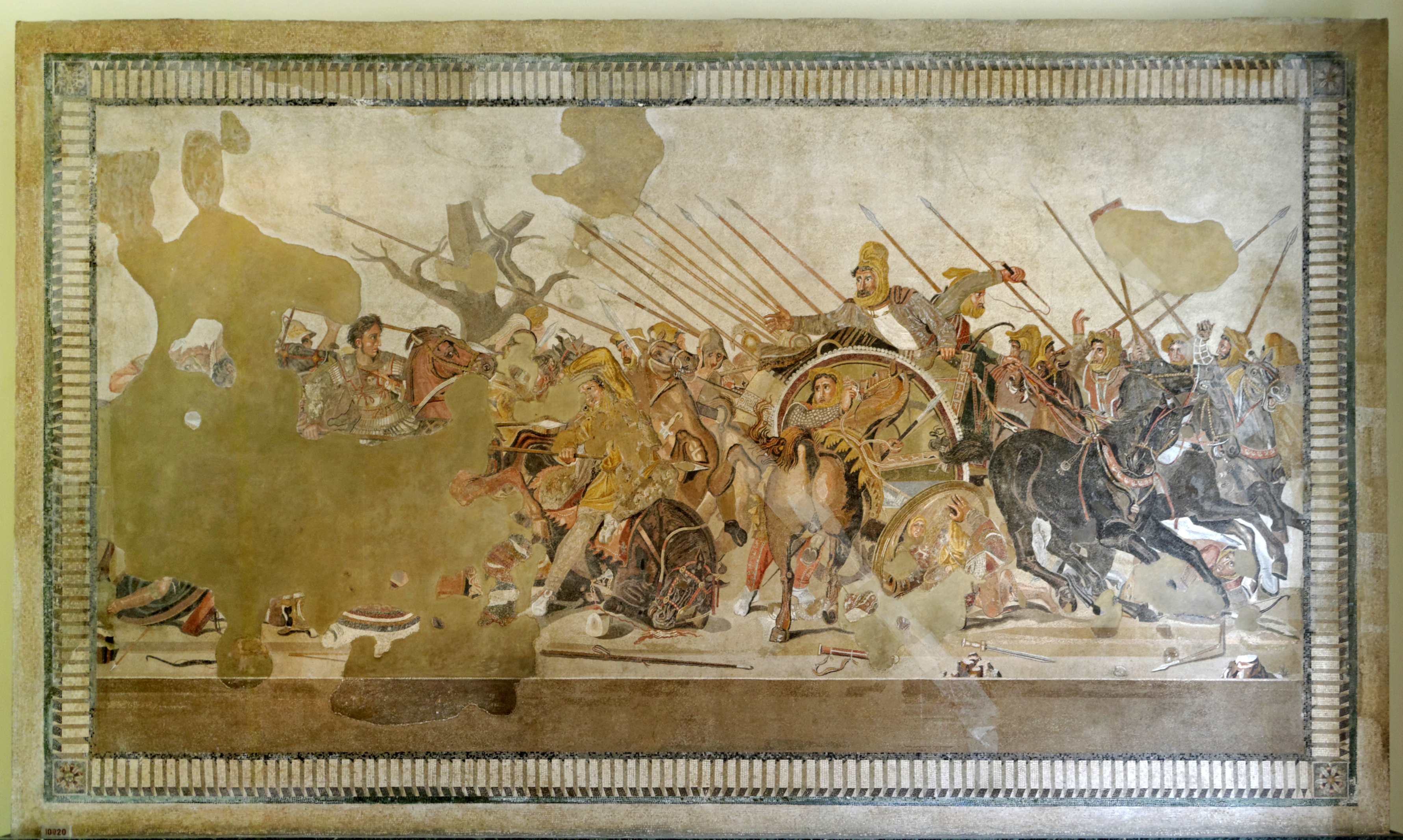|
Oxydates
Oxydates ( Old Persian: ''Waxsu-data'') was a Persian nobleman, who served as the satrap of Media under the Macedonian king Alexander the Great () from 330 BC to 328 BC. Before his appointment, Oxydates had for an unknown reason been imprisoned at Susa by his former suzerain, the Achaemenid ruler Darius III (). He was eventually found and released by Alexander, whom he accompanied to Rhagae. It was during that period Oxydates was appointed satrap of Media, thus replacing Atropates. However, he was convicted of misconduct in late 328 BC, and thus lost his office to Atropates. It unknown what happened to Oxydates afterwards. He may have been arrested or executed by Atropates at the instruction of Alexander, or even managed to escape. Following Oxydates' dismissal, a Mede named Baryaxes rebelled, donning a upright tiara A tiara (from la, tiara, from grc, τιάρα) is a jeweled head ornament. Its origins date back to ancient Greece and Rome. In the late 18th century, the tiar ... [...More Info...] [...Related Items...] OR: [Wikipedia] [Google] [Baidu] |
Atropates
Atropates ( peo, *Ātr̥pātaʰ and Middle Persian ; grc, Ἀτροπάτης ; c. 370 BC - after 321 BC) was a Persian nobleman who served Darius III, then Alexander the Great, and eventually founded an independent kingdom and dynasty that was named after him. Diodorus (18.4) refers to him as (), while Quintus Curtius (8.3.17) erroneously names him 'Arsaces'. Biography Towards the end of the Achaemenid Empire, Atropates was governor ('' satrap'') of the Achaemenid province of Media. In the decisive Battle of Gaugamela (October 331 BCE) between Darius and Alexander, Atropates commanded the Achaemenid troops of Media and Sacasene. Following his defeat in that battle, Darius fled to the Median capital of Ecbatana, where Atropates gave him hospitality. Darius attempted to raise a new army but was forced to flee Ecbatana in June 330 BCE. After Darius' death a month later at the hands of Bessus, Atropates surrendered to Alexander. Alexander initially chose Oxydates as satr ... [...More Info...] [...Related Items...] OR: [Wikipedia] [Google] [Baidu] |
Old Persian
Old Persian is one of the two directly attested Old Iranian languages (the other being Avestan language, Avestan) and is the ancestor of Middle Persian (the language of Sasanian Empire). Like other Old Iranian languages, it was known to its native speakers as (Iranian).''cf.'' , p. 2. Old Persian appears primarily in the inscriptions, clay tablets and seal (device), seals of the Achaemenid dynasty, Achaemenid era (c. 600 BCE to 300 BCE). Examples of Old Persian have been found in what is now Iran, Romania (Gherla), Armenia, Bahrain, Iraq, Turkey and Egypt, with the most important attestation by far being the contents of the Behistun Inscription (dated to 525 BCE). Recent research (2007) into the vast Persepolis Fortification Archive at the Oriental Institute at the University of Chicago unearthed Old Persian tablets, which suggest Old Persian was a written language in use for practical recording and not only for royal display. Origin and overview As a written language, Old ... [...More Info...] [...Related Items...] OR: [Wikipedia] [Google] [Baidu] |
Persians
The Persians are an Iranian ethnic group who comprise over half of the population of Iran. They share a common cultural system and are native speakers of the Persian language as well as of the languages that are closely related to Persian. The ancient Persians were originally an ancient Iranian people who had migrated to the region of Persis (corresponding to the modern-day Iranian province of Fars) by the 9th century BCE. Together with their compatriot allies, they established and ruled some of the world's most powerful empires that are well-recognized for their massive cultural, political, and social influence, which covered much of the territory and population of the ancient world.. Throughout history, the Persian people have contributed greatly to art and science. Persian literature is one of the world's most prominent literary traditions. In contemporary terminology, people from Afghanistan, Tajikistan, and Uzbekistan who natively speak the Persian language are know ... [...More Info...] [...Related Items...] OR: [Wikipedia] [Google] [Baidu] |
Media (region)
Media ( peo, 𐎶𐎠𐎭, Māda, Middle Persian: ''Mād'') is a region of north-western Iran, best known for having been the political and cultural base of the Medes. During the Achaemenid period, it comprised present-day Azerbaijan, Iranian Kurdistan and western Tabaristan. As a satrapy under Achaemenid rule, it would eventually encompass a wider region, stretching to southern Dagestan in the north. However, after the wars of Alexander the Great, the northern parts were separated due to the Partition of Babylon and became known as ''Atropatene'', while the remaining region became known as ''Lesser Media''. History Under the Medes In 678 BC, Deioces united the Median tribes of Media and made the first Iranian Empire. His grandson Cyaxares managed to unite all Iranian tribes of Ancient Iran and made his empire a major power. When Cyaxares died he was succeeded by his son, Astyages, who was the last king of the Median Empire. Under the Achaemenids In 553 BC, Cyrus the Grea ... [...More Info...] [...Related Items...] OR: [Wikipedia] [Google] [Baidu] |
Macedonia (ancient Kingdom)
Macedonia (; grc-gre, Μακεδονία), also called Macedon (), was an ancient kingdom on the periphery of Archaic and Classical Greece, and later the dominant state of Hellenistic Greece. The kingdom was founded and initially ruled by the royal Argead dynasty, which was followed by the Antipatrid and Antigonid dynasties. Home to the ancient Macedonians, the earliest kingdom was centered on the northeastern part of the Greek peninsula,. and bordered by Epirus to the west, Paeonia to the north, Thrace to the east and Thessaly to the south. Before the 4th century BC, Macedonia was a small kingdom outside of the area dominated by the great city-states of Athens, Sparta and Thebes, and briefly subordinate to Achaemenid Persia. During the reign of the Argead king PhilipII (359–336 BC), Macedonia subdued mainland Greece and the Thracian Odrysian kingdom through conquest and diplomacy. With a reformed army containing phalanxes wielding the ''sarissa'' pike, PhilipII d ... [...More Info...] [...Related Items...] OR: [Wikipedia] [Google] [Baidu] |
Alexander The Great
Alexander III of Macedon ( grc, wikt:Ἀλέξανδρος, Ἀλέξανδρος, Alexandros; 20/21 July 356 BC – 10/11 June 323 BC), commonly known as Alexander the Great, was a king of the Ancient Greece, ancient Greek kingdom of Macedonia (ancient kingdom), Macedon. He succeeded his father Philip II of Macedon, Philip II to the throne in 336 BC at the age of 20, and spent most of his ruling years conducting a lengthy military campaign throughout Western Asia and ancient Egypt, Egypt. By the age of thirty, he had created one of the List of largest empires, largest empires in history, stretching from Greece to northwestern Historical India, India. He was undefeated in battle and is widely considered to be one of history's greatest and most successful military commanders. Until the age of 16, Alexander was tutored by Aristotle. In 335 BC, shortly after his assumption of kingship over Macedon, he Alexander's Balkan campaign, campaigned in the Balkans and reasserted control ... [...More Info...] [...Related Items...] OR: [Wikipedia] [Google] [Baidu] |
Susa
Susa ( ; Middle elx, 𒀸𒋗𒊺𒂗, translit=Šušen; Middle and Neo- elx, 𒋢𒋢𒌦, translit=Šušun; Neo-Elamite and Achaemenid elx, 𒀸𒋗𒐼𒀭, translit=Šušán; Achaemenid elx, 𒀸𒋗𒐼, translit=Šušá; fa, شوش ; he, שׁוּשָׁן ; grc-gre, Σοῦσα ; syr, ܫܘܫ ; pal, 𐭮𐭥𐭱𐭩 or ; peo, 𐏂𐎢𐏁𐎠 ) was an ancient city in the lower Zagros Mountains about east of the Tigris, between the Karkheh and Dez Rivers in Iran. One of the most important cities of the Ancient Near East, Susa served as the capital of Elam and the Achaemenid Empire, and remained a strategic centre during the Parthian and Sasanian periods. The site currently consists of three archaeological mounds, covering an area of around one square kilometre. The modern Iranian town of Shush is located on the site of ancient Susa. Shush is identified as Shushan, mentioned in the Book of Esther and other Biblical books. Name The English name is derived ... [...More Info...] [...Related Items...] OR: [Wikipedia] [Google] [Baidu] |
Achaemenid Empire
The Achaemenid Empire or Achaemenian Empire (; peo, 𐎧𐏁𐏂, , ), also called the First Persian Empire, was an ancient Iranian empire founded by Cyrus the Great in 550 BC. Based in Western Asia, it was contemporarily the largest empire in history, spanning a total of from the Balkans and Egypt in the west to Central Asia and the Indus Valley in the east. Around the 7th century BC, the region of Persis in the southwestern portion of the Iranian plateau was settled by the Persians. From Persis, Cyrus rose and defeated the Median Empire as well as Lydia and the Neo-Babylonian Empire, marking the formal establishment of a new imperial polity under the Achaemenid dynasty. In the modern era, the Achaemenid Empire has been recognized for its imposition of a successful model of centralized, bureaucratic administration; its multicultural policy; building complex infrastructure, such as road systems and an organized postal system; the use of official languages across ... [...More Info...] [...Related Items...] OR: [Wikipedia] [Google] [Baidu] |
Darius III
Darius III ( peo, 𐎭𐎠𐎼𐎹𐎺𐎢𐏁 ; grc-gre, Δαρεῖος ; c. 380 – 330 BC) was the last Achaemenid King of Kings of Persia, reigning from 336 BC to his death in 330 BC. Contrary to his predecessor Artaxerxes IV Arses, Darius was a distant member of the Achaemenid dynasty. During his early career, he was reportedly an obscure figure among his peers and first rose to prominence during the Cadusian expedition of Artaxerxes III in the 350s BC. As a reward for his bravery, he was given the Satrapy of Armenia. Around 340 BC, he was placed in charge of the royal "postal service," a high-ranking position. In 338 BC, Artaxerxes III met an abrupt end after being poisoned by the court eunuch and chiliarch (''hazahrapatish'') Bagoas, who installed his youngest son Arses on the throne. He only reigned for a few years, until Bagoas had him poisoned as well. Darius was subsequently installed on the throne and soon forced Bagoas to drink his poison after discovering that ... [...More Info...] [...Related Items...] OR: [Wikipedia] [Google] [Baidu] |
Ray, Iran
Shahr-e Ray ( fa, شهر ری, ) or simply Ray (Shar e Ray; ) is the capital of Ray County in Tehran Province, Iran. Formerly a distinct city, it has now been absorbed into the metropolitan area of Greater Tehran as the 20th district of municipal Tehran, the capital city of the country. Historically known as Rhages (), Rhagae and Arsacia, Ray is the oldest existing city in Tehran Province. In the classical era, it was a prominent city belonging to Media, the political and cultural base of the Medes. Ancient Persian inscriptions and the Avesta (Zoroastrian scriptures), among other sources, attest to the importance of ancient Ray. Ray is mentioned several times in the Apocrypha. It is also shown on the fourth-century Peutinger Map. The city was subject to severe destruction during the medieval invasions by the Arabs, Turks, and Mongols. Its position as a capital city was revived during the reigns of the Buyid Daylamites and the Seljuk Turks. Ray is richer than many other ancient c ... [...More Info...] [...Related Items...] OR: [Wikipedia] [Google] [Baidu] |
Tiara
A tiara (from la, tiara, from grc, τιάρα) is a jeweled head ornament. Its origins date back to ancient Greece and Rome. In the late 18th century, the tiara came into fashion in Europe as a prestigious piece of jewelry to be worn by women at formal occasions. The basic shape of the modern tiara is a (semi-)circle, usually made of silver, gold or platinum, and richly decorated with precious stones, pearls or cameos. Tiaras were extremely popular during the late 19th century and were worn at events where the dress code was white tie. After World War I, wearing a tiara gradually fell out of fashion, except for official occasions at a royal court. Interest in tiaras has increased again since the beginning of the 21st century. The word "tiara" is often used interchangeably with the word "diadem". Description The basic shape of the modern tiara is a (semi-)circle, usually made of silver, gold or platinum. Tiaras have also been made from tortoiseshell, coral and quartz, and in ... [...More Info...] [...Related Items...] OR: [Wikipedia] [Google] [Baidu] |
Pasargadae
Pasargadae (from Old Persian ''Pāθra-gadā'', "protective club" or "strong club"; Modern Persian: ''Pāsārgād'') was the capital of the Achaemenid Empire under Cyrus the Great (559–530 BC), who ordered its construction and the location of his tomb. Today it is an archaeological site and one of Iran's UNESCO World Heritage Sites, about to the northeast of the modern city of Shiraz. History Pasargadae was founded in the 6th century BCE as the first capital of the Achaemenid Empire by Cyrus the Great, near the site of his victory over the Median king Astyages in 550 BCE. The city remained the Achaemenid capital until Darius moved it to Persepolis. The archaeological site covers 1.6 square kilometers and includes a structure commonly believed to be the mausoleum of Cyrus, the fortress of Toll-e Takht sitting on top of a nearby hill, and the remains of two royal palaces and gardens. Pasargadae Persian Gardens provide the earliest known example of the Persian '' chahar ba ... [...More Info...] [...Related Items...] OR: [Wikipedia] [Google] [Baidu] |









